
Also see: The Changing Map of Latin America
Also see: Across Latin America, a Struggle for Communal Land and Indigenous Autonomy
At the end of May, Mexico’s National Congress approved a political-electoral reform that will organize federal and local elections for the year 2015. Such a reform represents a step backward for indigenous towns in Mexico because it does not consider the way in which they elect authorities through their own system of “uses and customs” legitimate.
Despite efforts by citizens, academics, organizations and indigenous movements, who turned in a series of proposals to senators and congress members from Oaxaca long before the reform was passed, the self-determination of indigenous towns and communities has not been guaranteed.
“By not guaranteeing the right to autonomy and political representation in these towns, the diversity of political organization that exists in this country is being denied,” says Aldo Gonzales Rojas, of indigenous Zapotec descent and a director for the Secretary of Indigenous Affairs in the state of Oaxaca, where he ensures that indigenous laws are being instituted and applied correctly. “A legal gap has been created given that this other system exists, but is not recognized. Indigenous communities should have juridical certainty,” he continues.
The electoral adviser for the State Institute for Electoral Affairs and Citizen Participation of Oaxaca, Victor Leonel Juan Martínez, also says that the reform throws into question the autonomy of indigenous towns.
“Far from looking to meet with indigenous groups, they look to undermine their collective spirit; instead of establishing agreements, they see them as political clientele; far from constructing a national multicultural project, they seek out factious interests and use the indigenous flag as an instrument for their own ends,” he declared during the Thirteenth Session of the United Nations’ Permanent Forum on Indigenous Affairs, which took place in May of this year.
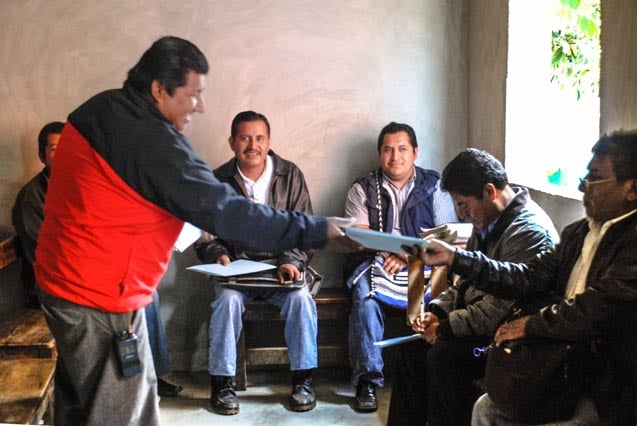 Community belonging to Oaxaca Nochixtlan receive information on how the electoral processes through political parties operate. (Photo: Santiago Navarro F.)
Community belonging to Oaxaca Nochixtlan receive information on how the electoral processes through political parties operate. (Photo: Santiago Navarro F.)
In contrast to this situation is the new reform initiative on indigenous rights and culture that is in process in Oaxaca’s state congress. “In Oaxaca’s state congress there is currently a proposal being debated for constitutional reform with regard to indigenous affairs, which would address electoral issues in these towns and guarantee the autonomy of indigenous communities,” Gonzales tells Truthout. In this way, “If federal laws do not regulate these issues, we are going to work so that they are regulated in the best way possible in the Constitution and the laws of the State; in Oaxaca, we cannot leave this issue aside.”
According to the Federal Electoral Institute, there are no federal level statistics of the number of municipalities that elect their authorities through the system of “uses and customs.” The only state in the country that legally recognizes this system is Oaxaca. Of the 570 municipalities that compose the state, 418 elect their authorities through “uses and customs.”
First Consultation of Indigenous Towns
To draft the proposal for the reform initiative, the secretary of Indigenous Affairs, a branch of the state government, issued a call for public comment and completed a consultation. Twenty-four regional forums took place with over 5,000 participants, among them 1,500 municipal authorities. There was also a state forum made up of 500 delegates representing each of the regional forums.
At first, indigenous leaders, academics and lawyers worked to create the reform’s fundamental criteria. These three integrated groups completed studies and analyzed national and international laws that have served as references for indigenous processes. From that point, they identified the central discussion points, including: indigenous modes of communication, culture, traditional medicine, indigenous women, community values, governing systems, electoral processes, autonomy, self-determination (in terms of land and territory), state jurisdiction and consultation.
A platform was constructed for each of these themes, and they were subjected to a consultation process. From there, a publication was compiled with these criteria that was sent to community authorities so that they could revise and discuss them. Shortly thereafter, an invitation call was put out in the places where consultations would take place. “They put out the call based on the principle that the state should listen to the towns before making reforms and laws. It is the first consultation that was done for indigenous towns in Oaxaca,” says Melquiades Cruz Miguel, head of the Department of Indigenous Intercultural Communication, part of the Secretary of Indigenous Affairs, which also was a participant in the consultation process in the Northern Sierra Mountains.
Once the forums had taken place, a technical committee of experts was created and made up of intellectuals, lawyers and indigenous leaders to convert the results of the consultation into a bill format.
Once this process was finished, a state forum of indigenous towns was convened to ensure that the final version of the document had support. “And, finally, the text was presented to a consulting board made up of intellectuals and indigenous leaders, in order to validate and legitimate the consultation,” Cruz says.
The proposal was presented to the governor of Oaxaca, Gabino Cué Monteagudo, in August of 2013. The text passed through the government’s technical advisory board, and in March of 2013, was sent to the state congress to be voted on.
A final resolution is expected in October. “We don’t know if members of congress are going to approve the full reform or an amended version, because – given that it deals with territory, autonomy, [and] indigenous jurisdiction – it affects many interests,” says Cruz.
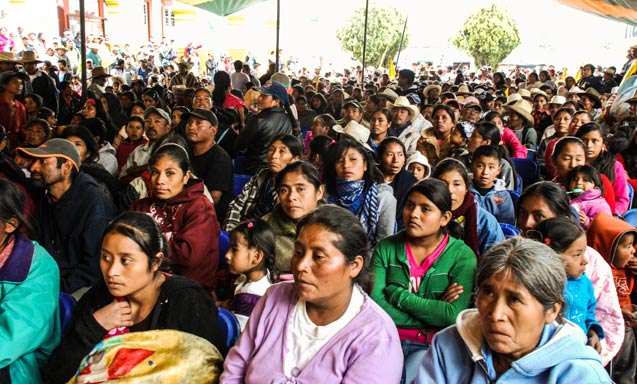 Assembly of communities that listen to what candidates offer in exchange for their vote. (Photo: Santiago Navarro F.)
Assembly of communities that listen to what candidates offer in exchange for their vote. (Photo: Santiago Navarro F.)
Strengthening of Assemblies
The reform initiative looks from the start to strengthen the interwoven nature of indigenous communities. “Rights for communities are strengthened, and decisions made in community assemblies are recognized to have effects beyond the town, which is to say, the State has to respect their decisions,” says Gonzales.
The proposal establishes mechanisms so communities can manage their development plans, put into place actions that they’ve decided on, and evaluate and regulate them. “It is recognized that communities have their own mechanisms, from planning to controlling their resources.”
Another aspect of the reform is that it guarantees the right of communities to prior, formal, free and informed consent in the case of administrative actions on the part of municipal and state governments. “It is not easy, but, for example, in cases of land concessions made to mining companies, one of the requirements they ask for is that the change of subsoil use be granted by the municipal authority. The proposal is that this change of subsoil use pass the assembly,” he explains.
Cuts to the Proposal
According to Victor Leonel Juan Martínez, before sending the bill to congress, the governor removed two fundamental pieces that had come out of the consultation. The initial proposal would establish an autonomous institute of indigenous Oaxacan towns, an institution that would be fundamental to carry forward public policies. “And when the governor presented [the bill] to the congress, the proposal for the institute was no longer there.”
Another proposal that was not accepted completely was one that would establish the possibility for municipalities that are governed by their own normative systems to be able to name their congressional representatives through mechanisms other than political parties.
“There are some actors that have little experience with the subject of indigenous towns, that have fears around the right to autonomy and free determination of towns and try to minimize some of the proposals,” notes Gonzales.
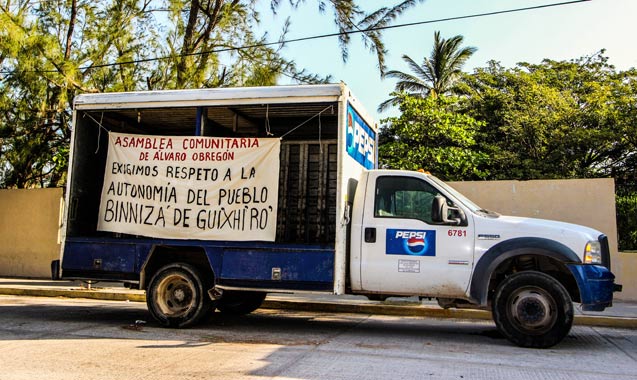 Community resistance to one of 28 wind farms planned for the region known to the state and decides declared autonomous municipality. (Photo: Santiago Navarro F.)
Community resistance to one of 28 wind farms planned for the region known to the state and decides declared autonomous municipality. (Photo: Santiago Navarro F.)
Forces within the Dispute
For Gonzales, one fact that should generate more controversy has to do with the political rights of indigenous communities, such as the proposed creation of an indigenous parliament, which he believes most likely will not pass in its entirety. “Certainly something general in this respect will be part of the Constitution.”
A reform of this nature has generated vehement dispute within the State, he tells Truthout. “It cannot be forgotten that Oaxaca is essentially indigenous, and the state owes an enormous debt to these towns. The passage of a reform of this nature would mean doing justice. To not approve it would be an injustice. Indigenous towns have been invisible. The liberal state was constructed as an agreement between French and North American perspectives. No one turned to see that indigenous towns also had their proposals.”
Limits
Gonzales admits the limitations of the law. “When the reform is approved, indigenous groups will have new legal resources to defend their lands. But it is not simple. There is no oral mechanism [for communicating the existence of the laws], they are not easily accessible, lawyers are necessary in order to access these tools. It will be necessary to go through a trial period.”
Cruz warns that the passage of the constitutional reform will not be sufficient if it does not guarantee the operation of new institutions that bring about public policies for indigenous towns. “If this does not happen, the same thing will happen as when the law was passed in 1998: it was inconsequential. It’s necessary to regulate, to define how the laws will be applied, which institutions should manage them and where resources should come from. The work we have to do after the law is passed is much greater. It is necessary to have mechanisms in place so that all of this can get off the ground.”
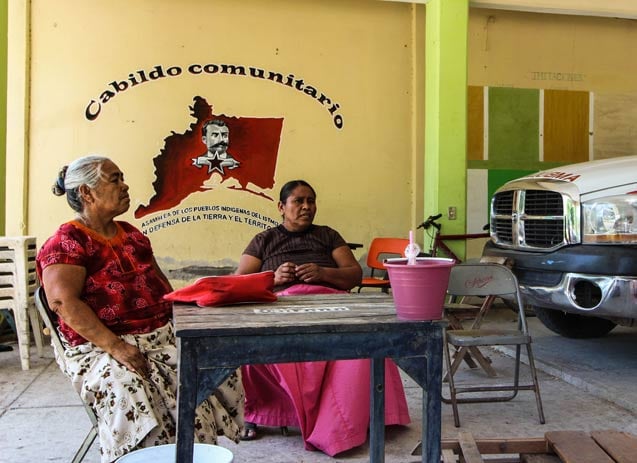 Women caring declared autonomous municipality. (Photo: Santiago Navarro F.)
Women caring declared autonomous municipality. (Photo: Santiago Navarro F.)
History
According to indigenous lawyer and jurist Francisco López Bárcenas, indigenous towns in Oaxaca have a long history and tradition of defending their rights; they have learned how to work together to have a relationship with the state and the rest of society while maintaining their ethnic identity. This has been reflected in the constitutions and laws that have guided the political life of this federative entity since before the creation of the Mexican State.
“The state of Oaxaca counts among its achievements having been the first of the Mexican Republic to legislate around the issue of indigenous rights, long before the federal government signed the United Nations ILO-Convention 169 on Indigenous and Tribal towns in Independent Countries in 1989, and prior to the reform of the 4th article of the Political Constitution of the United States of Mexico, where for the first time the pluri-cultural nature of the nation and some cultural rights were recognized, based on the presence of its indigenous towns,” says López Bárcenas.
Another important factor was the uprising of the armed movement of the Zapatista National Liberation Army in 1994, comprised primarily of indigenous individuals, which marked a new generation in the indigenous movement in Mexico and across the world.
“It was an important watershed moment for the vindication of the rights of indigenous towns in Mexico and in the world. The EZLN uprising and the San Andrés Accords particularly, regarding indigenous rights and culture, were fundamental factors for the generation of a strong national indigenous movement that made up the National Indigenous Congress, which in turn became a principle representative – together with the EZLN – for the demands of indigenous towns.” These are the antecedents that form the basis of the documents of this new reform initiative.
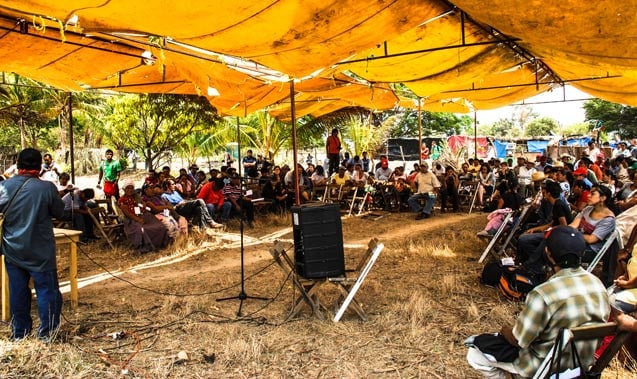 Assembly against cumunidades and organizations belonging to the company Fenosa Gas wind farm. (Photo: Santiago Navarro F.)
Assembly against cumunidades and organizations belonging to the company Fenosa Gas wind farm. (Photo: Santiago Navarro F.)
Contradictions
The juridical tools have been important so that towns can be recognized as collective legal subjects. But these communities exist, with or without this recognition, and continue to strengthen their community ties and their autonomy. Those that are disobedient and rebellious will continue to be a minority, but they continue building their daily lives, with or without permission.
“We have our forms of organizing ourselves that are deeply rooted, and what the law says on paper is one thing, but here everything has to go through the assembly, and we will continue living this way because it has worked well for us,” says Saúl Aquino, commissioner of communal resources in the Zapotec community of Capulálpam de Méndez.
“Indigenous towns must strengthen their processes of autonomy, preparing new generations for autonomy and not expecting anything good to come from the political class of this country,” says anthropologist and researcher Gilberto López y Rivas.
Translated by Miriam Taylor.
Press freedom is under attack
As Trump cracks down on political speech, independent media is increasingly necessary.
Truthout produces reporting you won’t see in the mainstream: journalism from the frontlines of global conflict, interviews with grassroots movement leaders, high-quality legal analysis and more.
Our work is possible thanks to reader support. Help Truthout catalyze change and social justice — make a tax-deductible monthly or one-time donation today.